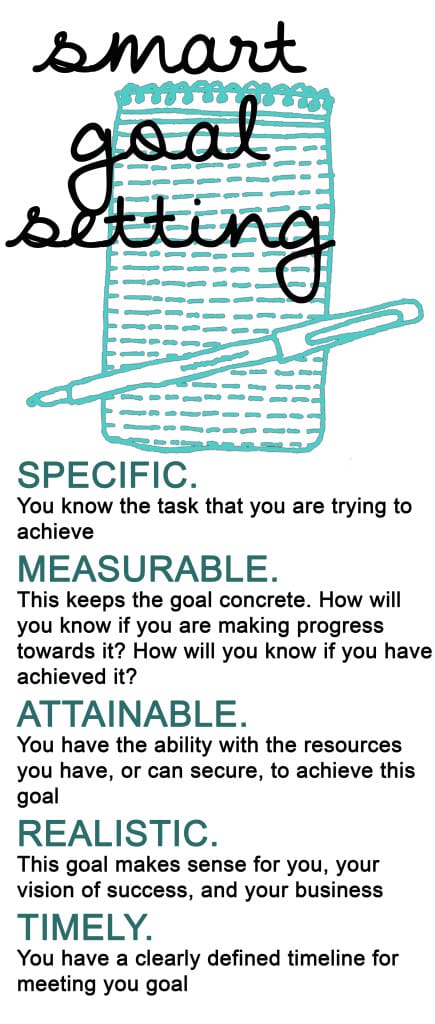smart goal setting
Growing up in Maine I was raised on Yankee ingenuity and work ethic. The idea that I always need to be striving towards something is deep within my cultural make up. However, drive, motivation and hard work are important when you are setting out to realize a project or grow your business, but not everything.
Projects can seem daunting and it can be hard to know where to begin. I have found that the best way for me to advance towards any project that seems daunting is to set incremental goals to get there. I was reminded of the importance of having a clear goal the other day when I was discussing my current project to reorient my decade long career of working for arts and cultural nonprofits towards creative and entrepreneurial start ups with a friend. I said, “I feel like I’m flailing aimlessly. I’m going to a lot of events and talking to a lot of people, but I’m not sure of the difference it’s going to make.” “Well,” she reminded me, “What’s your goal when you do these things?”
In my last column I discussed the importance of envisioning success and knowing what success looks, feels and acts like for your project or business before diving into the process of getting things done. Goals are a mechanism we can use to ensure that we keep our activities focused towards our dream of success.
But how do we set effective goals?
In graduate school when I was getting my Master’s in Public Administration I was inspired by the concept of S.M.A.R.T. goals. This idea may be familiar with you if you have taken business-planning classes. S.M.A.R.T. goals are:
Specific. You know the task that you are trying to achieve
Measurable. This keeps the goal concrete. How will you know if you are making progress towards it? How will you know if you have achieved it?
Attainable. You have the ability with the resources you have, or can secure, to achieve this goal
Realistic. This goal makes sense for you, your vision of success, and your business
Timely. You have a clearly defined timeline for meeting you goal
To simplify the goal setting process, I created a “Goal Madlib,” which I have been using in my “Plan and Grow Your Dream Project” workshops this summer. If you are unsure how to structure a S.M.A.R.T. goal, try this:
Action verb + quantifiable task accomplished + time by which I am done
For example, if your vision is to launch your own line of silk-screened t-shirts featuring your own design and you are planning for a holiday craft fair, you could write goals like:
Create three new t-shirt designs by October 15
Silkscreen 50 t-shirts by November 15
From here, you can break these goals into “bite sized” action steps. Action steps are small tasks that you can accomplish to achieve your goal. For example, before I started silk-screening my t-shirts I would need to research, price and purchase supplies.
To ensure your goals are effective, set about three to five at a time per project. If you have too many goals you may feel as if you are doing too much at once. I learned this lesson clearly when I worked as a museum educator. I had an hour-and-a-half to give middle school students a tour of the Ancient Egyptian art collection at the museum where I worked. In planning my lessons I had to stay focused. Did I want them to have a good time in the museum, understand ancient Egyptian burial customs, learn to read basic hieroglyphics, become familiar with ancient Egyptian religion, and practice drawing in the museum? Sure I did, but that was way too much for one lesson. By focusing more narrowly on three goals per lesson my students were able to get more out of their museum visit.
The same is true for goal setting for a creative business or project. Keep your goals focused so you can achieve them, reflect upon them and set new ones as you move towards your larger vision of success. I tend to revisit my goals each season – the change in the weather inspires me to check in on the state of my projects. I’m in the process of reflecting and setting new goals for the fall.
What are your goals this season?
-eleanor
ABOUT ELEANOR:
Eleanor Callott Whitney is a writer, rock musician, educator, and arts administrator raised in Maine and living in Brooklyn. She finds joy in bringing order to the chaos of creativity, empowering artists with the tools they need to think of themselves as entrepreneurs and in managing and facilitating creative projects with panache. She is the author of Grow: How to take your DIY project and passion to the next level and quit your job! and writes extensively about art, culture and nonprofit management. She published the personal, art zine Indulgence for 15 years, as well as co-founded the Portland Zine Symposium and has worked for the New York Foundation for the Arts, the Brooklyn Museum, and P.O.V./American Documentary. She is the proud recipient of a Master’s degree in Public Administration from Baruch College where she learned to stop worrying and love statistical and budgetary analysis.




3 Comments